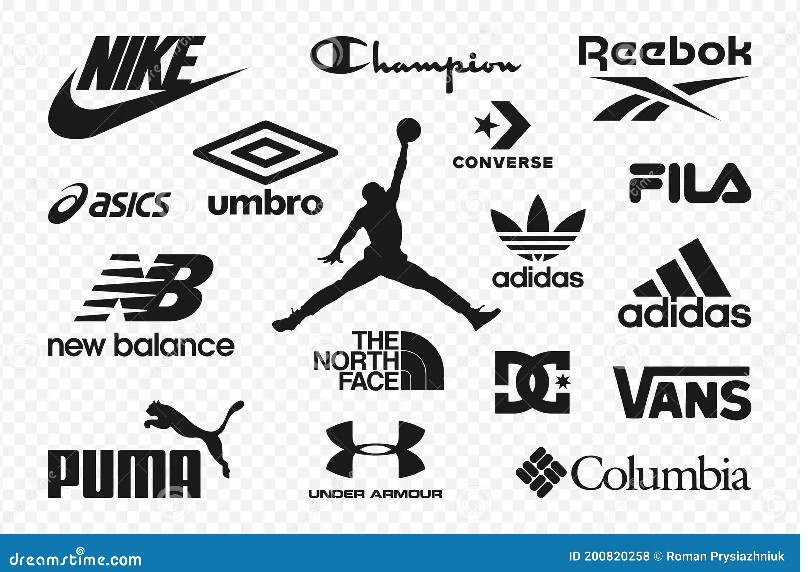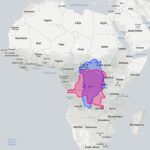The global sports goods market is a dynamic and lucrative sector, reaching a staggering US$ 295 billion in global sales, with the United States contributing a significant 35%, exceeding US$ 100 billion annually. Within this massive market, a few dominant players fiercely compete for market share, brand recognition, and ultimately, revenue. This article delves into a comparative analysis of the economic revenue of three giants in the sportswear industry: Under Armour (UA), Nike, and Adidas, highlighting their financial performance, key strategies, and market positioning.
Image alt text: 2022 Revenue Comparison of Top Sports Goods Groups in US Billion Dollars, featuring Nike, Adidas, VF Corporation, LVMH, and other leading brands.
In 2022, the top 10 sports corporate groups collectively generated US$ 118 billion in sales, showcasing the immense economic power concentrated within this industry. VF Corporation, with brands like Vans and The North Face, stood out with US$ 11.8 billion in revenue, demonstrating the strength of a diversified brand portfolio in capturing different market segments.
Image alt text: VF Group 2022 Sales Revenue Breakdown in US Billion Dollars by Geographic Region including United States, Europe, Asia Pacific, and Rest of Americas.
However, the core battleground in the sports market is dominated by the “Big 4”: Nike, Adidas, Puma, and Under Armour. These brands are engaged in a constant competition for endorsements, sponsorships, and consumer loyalty, driving significant marketing expenditure and shaping trends in sports and fashion.
Image alt text: Retail storefronts of Nike, Adidas, Puma, and Under Armour showcasing their athletic apparel and footwear products.
In 2022, the combined revenues of these four brands reached US$ 85 billion, with Nike leading the pack. Nike alone generated US$ 46.7 billion in revenue and a profit of US$ 6 billion, exceeding the combined revenue of Adidas, Puma, and Under Armour, which totaled US$ 38 billion. Adidas, while a strong second, reported revenues of US$ 23.6 billion but significantly lower profits of only US$ 239 million, highlighting a gap in profitability compared to Nike. Adidas’s peak profitability was in 2019 with US$ 2.2 billion, indicating fluctuating financial performance in recent years.
Image alt text: Historical Combined Revenue Trend in US Billion Dollars for Nike, Adidas, Puma, and Under Armour from 2019 to 2022, showing market recovery after 2020.
The sports market experienced revenue dips during the pandemic in 2020, but a swift recovery followed, fueled by digital sales acceleration. The combined revenue of the Big 4 grew from US$ 77 billion in 2019 to US$ 70 billion in 2020, then rebounded to US$ 81 billion in 2021 and further to US$ 85 billion in 2022, demonstrating market resilience and continued growth.
Image alt text: Annual Revenue Growth Percentage Comparison in US Dollars for Nike, Adidas, Puma, and Under Armour, highlighting growth rates over recent years.
Nike’s dominance is especially pronounced in footwear, with 62% of its revenue coming from sneaker sales. Adidas follows with 55%, Puma with 51%, while Under Armour is significantly less reliant on footwear, with only 22% of its revenue from this category. In 2022, Nike’s sneaker sales reached US$ 29.1 billion, including substantial figures from North America (US$ 12.2 billion) and EMEA (US$ 7.4 billion). Nike’s apparel line also performed strongly, generating US$ 13.6 billion, indicating further growth potential in this segment.
In comparison, Adidas’s footwear sales were US$ 13 billion, and apparel sales reached US$ 9.1 billion in 2022. Puma achieved US$ 4.5 billion in sneaker sales and US$ 3 billion in apparel. Under Armour, however, heavily relies on apparel, generating US$ 3.9 billion compared to just US$ 1.3 billion in footwear revenue, indicating a different product focus and market strategy.
Image alt text: Sales by Category Percentage Breakdown for Nike, Adidas, Puma, and Under Armour in 2022, comparing Footwear, Apparel, and Other product segments.
Image alt text: Global Adidas Sales in US Billion Dollars for 2022 broken down by geographic region including Europe, North America, Greater China, and Emerging Markets.
While Nike maintains its market leadership, Puma has demonstrated remarkable growth, with a 28% revenue increase in 2022, significantly outpacing Nike’s 5% growth. Puma’s revenue reached US$ 8.9 billion in 2022, a substantial increase from US$ 4.7 billion in 2017, showcasing consistent double-digit growth. Under Armour, with US$ 5.7 billion in revenue in 2022, is lagging behind Puma in terms of growth trajectory.
Image alt text: Puma marketing campaign featuring Neymar Jr. highlighting athlete endorsement strategy in sports marketing.
Marketing investment is a cornerstone of success in the sports goods industry. In 2022, the Big 4 collectively invested US$ 8.4 billion in marketing, averaging 11% of their sales revenue. Nike led with US$ 3.9 billion (8% of sales), while Adidas invested US$ 2.9 billion (12% of sales). Puma’s marketing budget has significantly increased, reaching US$ 1.1 billion in 2022, reflecting its aggressive growth strategy.
Image alt text: Marketing Budget Comparison in US Billion Dollars for Nike, Adidas, Puma, and Under Armour in 2022, illustrating marketing investment levels.
Image alt text: Visual representation of numerous sports teams globally sponsored by Nike, showcasing brand reach and marketing through team partnerships.
Image alt text: Compilation of Adidas sports sponsorships including major football clubs and national teams, highlighting brand visibility through sports partnerships.
Image alt text: Graph comparing Puma’s marketing budget growth against Under Armour’s marketing budget, showing Puma’s increased investment in recent years.
Image alt text: Under Armour marketing image featuring a sponsored athlete, demonstrating their use of athlete endorsements in marketing.
Profitability in the sports goods market is influenced by high operating costs and substantial investments. Direct-to-consumer (D2C) sales are becoming increasingly important, now accounting for over 40% of sales for many brands, enhancing profit margins by cutting out intermediaries.
Image alt text: Graphic illustrating the increasing trend and importance of Direct to Consumer (D2C) sales strategy for sports brands.
Image alt text: Interior view of an Adidas retail store, representing the Direct to Consumer sales channel through company-owned physical locations.
Over the past five years, Nike accumulated US$ 20 billion in net profits, significantly outperforming Adidas (US$ 6.7 billion) and Puma (US$ 1.3 billion). This profit disparity reinforces Nike’s financial strength and market leadership.
Image alt text: Net Profit Comparison in US Billion Dollars for Nike, Adidas, and Puma over the past five years, highlighting Nike’s substantial profit lead.
The Jordan brand, a subsidiary of Nike, exemplifies the power of athlete-driven brands. The partnership between Nike and Michael Jordan revolutionized the sneaker market and sports marketing. Jordan now earns significantly more from his Nike royalties than he did as a player, with estimated annual earnings around US$ 250 million. Michael Jordan’s net worth is estimated at US$ 3.5 billion, reflecting the immense success of this brand collaboration.
Image alt text: Iconic image of Michael Jordan and the Nike logo symbolizing the successful and revolutionary Jordan brand partnership.
The “Last Dance” documentary series further boosted Jordan brand sales, particularly through e-commerce during the pandemic lockdowns. The brand’s revenue exceeded US$ 5 billion in 2022, now representing 11% of Nike’s total sales, up from 8% previously.
Image alt text: Close-up shot of Air Jordan 1 sneakers, a flagship product of the Jordan brand, highlighting its cultural and market impact.
Image alt text: Promotional image for the “Last Dance” documentary series featuring Michael Jordan, showcasing the media impact on Jordan brand sales growth.
Image alt text: Historical Revenue Trend for the Jordan brand in US Billion Dollars, illustrating consistent growth and exceeding US$ 5 billion in 2022.
The Jordan brand’s success extends beyond basketball, with strategic associations with NBA teams and entry into soccer through Paris Saint-Germain (PSG), expanding its market reach and cultural relevance.
Image alt text: Visual representation of NBA teams wearing Jordan brand apparel, showcasing brand partnerships within professional basketball.
Image alt text: Paris Saint-Germain (PSG) football kit featuring the Jordan brand logo, illustrating brand expansion into football/soccer through strategic team sponsorships.
The Jordan brand’s growth rate consistently outpaces Nike’s overall growth, emphasizing its significant contribution to Nike’s financial performance.
Image alt text: Growth Percentage Comparison between Jordan brand and Nike overall, highlighting Jordan brand’s higher growth rate.
Interestingly, the Jordan brand, as a sub-brand, sells more sports sneakers globally than Adidas, surpassing even major competitors in sneaker sales volume.
Image alt text: Image of valuable and collectible Air Jordan sneakers at auction, representing the high value and desirability of Jordan brand products.
Image alt text: Chart comparing global sneaker sales by brand, indicating Jordan brand’s strong performance relative to major competitors like Adidas.
Comparing Jordan to Converse, another Nike-owned brand focused on lifestyle, highlights Jordan’s exceptional growth. In 2017, Converse generated US$ 2 billion in revenue, while Jordan generated US$ 3.1 billion. By 2022, Converse grew to US$ 2.3 billion, but Jordan surged to US$ 5.1 billion, widening the revenue gap and demonstrating Jordan’s superior market momentum.
Image alt text: Growth Percentage Comparison between Jordan brand and Converse, showing Jordan brand’s significantly higher growth rate compared to Converse.
Beyond Jordan, other athlete-specific brands like LeBron James (Nike) and Stephen Curry (Under Armour) also contribute significantly to revenue. The LeBron James brand generates over US$ 600 million annually for Nike. Stephen Curry’s partnership with Under Armour has driven sales growth for the brand, leveraging his popularity and market appeal. Lionel Messi’s Adidas sponsorship benefits Adidas, particularly in the US market, leveraging “Messimania” and Adidas’s sponsorship of Major League Soccer (MLS).
Image alt text: LeBron James featured in Nike marketing materials, representing the LeBron James Nike sub-brand and athlete-specific product lines.
Image alt text: Stephen Curry in Under Armour apparel, highlighting the Stephen Curry Under Armour brand partnership and athlete endorsement strategy.
Image alt text: Lionel Messi wearing Adidas gear, representing the Lionel Messi Adidas sponsorship and its impact on brand visibility and sales.
Image alt text: Adidas branded retail space showcasing MLS (Major League Soccer) merchandise, highlighting Adidas’s sponsorship of the league and market activation.
Image alt text: YouGov BrandIndex score comparison chart for sports brands, indicating brand perception and consumer sentiment metrics.
Image alt text: Lionel Messi wearing Inter Miami CF Adidas kit, showcasing the impact of Messi’s move to MLS and Adidas’s sponsorship of the club.
In conclusion, Nike stands as the clear revenue leader in the sports goods market, driven by its strong brand, successful footwear segment, and highly profitable Jordan sub-brand. Adidas remains a strong competitor but faces profitability challenges. Puma is emerging as a significant growth player, closing the gap with Under Armour, which is more apparel-focused and experiencing slower growth. Marketing investments and strategic athlete endorsements are critical for all brands in this competitive landscape, shaping consumer demand and brand success. The ongoing battle for market share among these giants will continue to define the economic landscape of the global sports industry.

